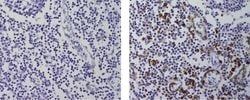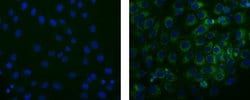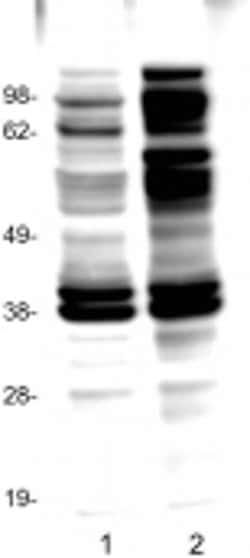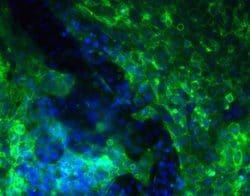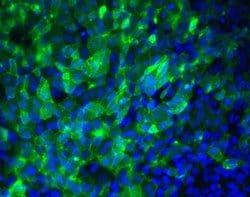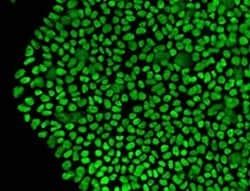50-112-2876
Blood Group Antigen H (O) Type 1 Monoclonal Antibody (17-206), eBioscience™, Invitrogen™
Manufacturer: Invitrogen
Select a Size
| Pack Size | SKU | Availability | Price |
|---|---|---|---|
| Each of 1 | 50-112-2876-Each-of-1 | In Stock | ₹ 32,040.00 |
50-112-2876 - Each of 1
In Stock
Quantity
1
Base Price: ₹ 32,040.00
GST (18%): ₹ 5,767.20
Total Price: ₹ 37,807.20
Antigen
Blood Group Antigen H (O) Type 1
Classification
Monoclonal
Concentration
0.5 mg/mL
Formulation
PBS with 0.09% sodium azide; pH 7.2
Host Species
Mouse
Quantity
100 μg
Primary or Secondary
Primary
Content And Storage
4° C
Form
Liquid
Applications
ELISA, Immunohistochemistry (Paraffin)
Clone
17-206
Conjugate
Unconjugated
Gene Alias
ABH; BG-H; BG-H1; group h
Purification Method
Affinity chromatography
Regulatory Status
RUO
Target Species
Human
Product Type
Antibody
Isotype
IgG3
Description
- Description: The monoclonal antibody 17-206 recognizes the human blood group antigen H (O) type 1, a subtype primarily found in epithelial and secretory cells
- The precursor H antigen is modified by addition of saccharides to carbohydrate chains of proteins and lipids on erythrocytes and epithelial cells
- The type, attachment, location, and sequence of saccharides determines the blood group antigen subtype and is mediated by multiple glycosyl transferases
- Depending on ABO blood type, the H antigen is converted into either the A antigen, B antigen, both the A and B antigen, or left unconverted (O antigen)
- Evidence that the blood group antigen H is not expressed in tumor cells and that the level correlates with disease progression suggests that the blood group antigen H may be involved in cell proliferation, cell adhesion, and angiogenesis, although its exact function remains to be determined
- The 17-206 antibody does not recognize blood group antigen H (O) type 2
- Applications Reported: This 17-206 antibody has been reported for use in immunohistochemical staining of formalin-fixed paraffin embedded tissue sections and ELISA
- Applications Tested: This 17-206 antibody has been tested by immunohistochemistry on formalin-fixed paraffin embedded human tissue using either high or low pH antigen retrieval at less than or equal to 5 μg/mL
- It is recommended that the antibody be carefully titrated for optimal performance in the assay of interest
- The H antigen is a precursor to the ABO blood group antigens, present in people of all common blood types
- The Bombay phenotype (hh) does not express antigen H on red blood cells, and therefore this type will also lack A or B antigens, similar to the O blood group
- However, unlike O group, the H antigen is absent, hence the individuals produce isoantibodies to antigen H as well as to both A and B antigens
- If they receive blood from someone with O blood group, the anti-H antibodies will bind to the H antigen on the red blood cells of the donor blood and destroy the RBCs by complement-mediated lysis
- Therefore, people with Bombay phenotype can receive blood only from other hh donors, although they can donate as though they were type O
- Some individuals with the blood group A1 may also be able to produce anti-H antibodies due to the complete conversion of all the H antigen to A1 antigen
- Production of the H antigen, or its deficiency in the Bombay phenotype, is controlled at the H locus on chromosome 19
- The H locus contains three exons that span more than 5 kb of genomic DNA, and encodes the fucosyltransferase that produces the H antigen on RBCs
- The H antigen is a carbohydrate sequence with carbohydrates linked mainly to protein (with a minor fraction attached to ceramide moiety).
Compare Similar Items
Show Difference
Antigen: Blood Group Antigen H (O) Type 1
Classification: Monoclonal
Concentration: 0.5 mg/mL
Formulation: PBS with 0.09% sodium azide; pH 7.2
Host Species: Mouse
Quantity: 100 μg
Primary or Secondary: Primary
Content And Storage: 4° C
Form: Liquid
Applications: ELISA, Immunohistochemistry (Paraffin)
Clone: 17-206
Conjugate: Unconjugated
Gene Alias: ABH; BG-H; BG-H1; group h
Purification Method: Affinity chromatography
Regulatory Status: RUO
Target Species: Human
Product Type: Antibody
Isotype: IgG3
Antigen:
Blood Group Antigen H (O) Type 1
Classification:
Monoclonal
Concentration:
0.5 mg/mL
Formulation:
PBS with 0.09% sodium azide; pH 7.2
Host Species:
Mouse
Quantity:
100 μg
Primary or Secondary:
Primary
Content And Storage:
4° C
Form:
Liquid
Applications:
ELISA, Immunohistochemistry (Paraffin)
Clone:
17-206
Conjugate:
Unconjugated
Gene Alias:
ABH; BG-H; BG-H1; group h
Purification Method:
Affinity chromatography
Regulatory Status:
RUO
Target Species:
Human
Product Type:
Antibody
Isotype:
IgG3
Antigen: SOX2
Classification: Monoclonal
Concentration: 0.5 mg/mL
Formulation: PBS with 0.09% sodium azide; pH 7.2
Host Species: Rat
Quantity: 25 μg
Primary or Secondary: Primary
Content And Storage: 4° C
Form: Liquid
Applications: ELISA, Flow Cytometry, Immunocytochemistry, Immunohistochemistry (Paraffin), Western Blot
Clone: Btjce
Conjugate: Unconjugated
Gene Alias: ANOP3; cb236; Delta EF2a; lcc; MCOPS3; MCOPS3 (Microphthalmia Syndromic type 3); RGD1565646; sex determining region Y-box 2; SOX 2; SOX2; Sox-2; soxp; SRY (sex determining region Y) box 2; SRY (sex determining region Y)-box 2; SRY box 2; SRY related HMG box 2; SRY-box 2; SRY-box 2; SOX2; SRY-box containing gene 2; SRY-box transcription factor 2; SRY-related HMG-box gene 2; transcription factor SOX2; transcription factor SOX-2; wu:fb83g04; wu:fc14d07; ysb; zgc:65860; zgc:77389
Purification Method: Affinity chromatography
Regulatory Status: RUO
Target Species: Human, Mouse
Product Type: Antibody
Isotype: IgG2a κ
Antigen:
SOX2
Classification:
Monoclonal
Concentration:
0.5 mg/mL
Formulation:
PBS with 0.09% sodium azide; pH 7.2
Host Species:
Rat
Quantity:
25 μg
Primary or Secondary:
Primary
Content And Storage:
4° C
Form:
Liquid
Applications:
ELISA, Flow Cytometry, Immunocytochemistry, Immunohistochemistry (Paraffin), Western Blot
Clone:
Btjce
Conjugate:
Unconjugated
Gene Alias:
ANOP3; cb236; Delta EF2a; lcc; MCOPS3; MCOPS3 (Microphthalmia Syndromic type 3); RGD1565646; sex determining region Y-box 2; SOX 2; SOX2; Sox-2; soxp; SRY (sex determining region Y) box 2; SRY (sex determining region Y)-box 2; SRY box 2; SRY related HMG box 2; SRY-box 2; SRY-box 2; SOX2; SRY-box containing gene 2; SRY-box transcription factor 2; SRY-related HMG-box gene 2; transcription factor SOX2; transcription factor SOX-2; wu:fb83g04; wu:fc14d07; ysb; zgc:65860; zgc:77389
Purification Method:
Affinity chromatography
Regulatory Status:
RUO
Target Species:
Human, Mouse
Product Type:
Antibody
Isotype:
IgG2a κ
Antigen: PU.1
Classification: Monoclonal
Concentration: 0.5 mg/mL
Formulation: PBS with 0.09% sodium azide; pH 7.2
Host Species: Mouse
Quantity: 100 μg
Primary or Secondary: Primary
Content And Storage: 4° C
Form: Liquid
Applications: Immunocytochemistry, Immunohistochemistry (Paraffin), Western Blot
Clone: phpu13
Conjugate: Unconjugated
Gene Alias: 31 kDa transforming protein; 31 kDa-transforming protein; 31kDa Transforming Protein; Dis1; Dis-1; hCG_25181; hematopoietic transcription factor PU.1; OF; Pu.1; SFFV proviral integration 1; SFFV proviral integration 1 protein; Sfpi1; Sfpi-1; Spi1; SPI-1; Spi-1 proto-oncogene; SPIA; SPI-A; spleen focus forming virus (SFFV) proviral integration oncogene; spleen focus forming virus (SFFV) proviral integration oncogene spi1; spleen focus forming virus proviral integration oncogene spi1; Tcfpu1; Tfpu.1; Transcription factor PU.1; Transcription Factor spi1
Purification Method: Affinity chromatography
Regulatory Status: RUO
Target Species: Human, Mouse
Product Type: Antibody
Isotype: IgG1 κ
Antigen:
PU.1
Classification:
Monoclonal
Concentration:
0.5 mg/mL
Formulation:
PBS with 0.09% sodium azide; pH 7.2
Host Species:
Mouse
Quantity:
100 μg
Primary or Secondary:
Primary
Content And Storage:
4° C
Form:
Liquid
Applications:
Immunocytochemistry, Immunohistochemistry (Paraffin), Western Blot
Clone:
phpu13
Conjugate:
Unconjugated
Gene Alias:
31 kDa transforming protein; 31 kDa-transforming protein; 31kDa Transforming Protein; Dis1; Dis-1; hCG_25181; hematopoietic transcription factor PU.1; OF; Pu.1; SFFV proviral integration 1; SFFV proviral integration 1 protein; Sfpi1; Sfpi-1; Spi1; SPI-1; Spi-1 proto-oncogene; SPIA; SPI-A; spleen focus forming virus (SFFV) proviral integration oncogene; spleen focus forming virus (SFFV) proviral integration oncogene spi1; spleen focus forming virus proviral integration oncogene spi1; Tcfpu1; Tfpu.1; Transcription factor PU.1; Transcription Factor spi1
Purification Method:
Affinity chromatography
Regulatory Status:
RUO
Target Species:
Human, Mouse
Product Type:
Antibody
Isotype:
IgG1 κ
Antigen: Cutaneous Lymphocyte Antigen (CLA)
Classification: Monoclonal
Concentration: 0.5 mg/mL
Formulation: PBS with 0.09% sodium azide; pH 7.2
Host Species: Rat
Quantity: 100 μg
Primary or Secondary: Primary
Content And Storage: 4° C
Form: Liquid
Applications: Flow Cytometry, Functional Assay, Immunohistochemistry (Paraffin), Western Blot
Clone: HECA-452
Conjugate: Unconjugated
Gene Alias: CLA
Purification Method: Affinity chromatography
Regulatory Status: RUO
Target Species: Human
Product Type: Antibody
Isotype: IgM κ
Antigen:
Cutaneous Lymphocyte Antigen (CLA)
Classification:
Monoclonal
Concentration:
0.5 mg/mL
Formulation:
PBS with 0.09% sodium azide; pH 7.2
Host Species:
Rat
Quantity:
100 μg
Primary or Secondary:
Primary
Content And Storage:
4° C
Form:
Liquid
Applications:
Flow Cytometry, Functional Assay, Immunohistochemistry (Paraffin), Western Blot
Clone:
HECA-452
Conjugate:
Unconjugated
Gene Alias:
CLA
Purification Method:
Affinity chromatography
Regulatory Status:
RUO
Target Species:
Human
Product Type:
Antibody
Isotype:
IgM κ
